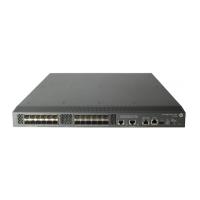195
Examples
# Clear statistics about global RSVP-TE.
<Sysname> reset mpls rsvp-te statistics global
static-cr-lsp egress
Description
Use the static-cr-lsp egress command to configure a static CR-LSP on the egress node.
Use the undo static-cr-lsp egress command to remove the static CR-LSP.
Related commands: mpls te tunnel-id.
Syntax
static-cr-lsp egress tunnel-name incoming-interface interface-type interface-number in-label in-label-value
undo static-cr-lsp egress tunnel-name
View
System view
Default level
2: System level
Parameters
tunnel-name: Specifies the tunnel name, which is a case-sensitive string of 1 to 15 characters.
incoming-interface interface-type interface-number: Specifies the incoming interface.
in-label in-label-value: Specifies the incoming label, which can be a value of 0, 3, or 16 through 1023.
Examples
# Configure a static CR-LSP on the egress node, setting its name to tunnel34, incoming interface to VLAN-
interface 3, and incoming label to 233.
<Sysname> system-view
[Sysname] static-cr-lsp egress tunnel34 incoming-interface vlan-interface 3 in-label 233
static-cr-lsp ingress
Description
Use the static-cr-lsp ingress command to configure a static CR-LSP at the ingress node.
Use the undo static-cr-lsp ingress command to remove the static CR-LSP.
The next hop address cannot be a local public address when configuring the static CR-LSP on the ingress
or a transit node.
Syntax
static-cr-lsp ingress tunnel-name destination dest-addr nexthop next-hop-addr out-label out-label-value
undo static-cr-lsp ingress tunnel-name
View
System view

